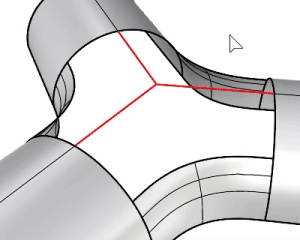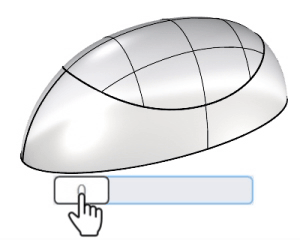FillSrf
|
Toolbar |
Menu |
|---|---|
|
|
Surface Fill Surface |
The FillSrf command creates a single surface to fill a closed boundary of curves or edges with specified continuities.

Steps
-
Select curves, surface edges, or point objects, press Enter when done.
The output surface cannot be trimmed if the input objects do not form a closed boundary.
-
Click the left or right mouse button on the dots on the input objects to cycle continuity forward or backward.
-
Set options.
FillSrf Options
Click this button to add or remove curves or edges used to define the boundary and interior shapes of the surface.
Set all (G0/G1/G2)
Sets the same constraint level to all boundary edges of the surface being filled.
Alternatively, you can hold Shift and left- or right-click a dot on a boundary edge to unify the constraint level.
Stiffness
Controls the roundness and flatness of the surface shape. Higher values produce flatter shapes.
-
Double-click the slider to enter a specific number.

Degree
Sets the UV degrees of the surface from 3 to 5.
Domain
Untrimmed
Creates an untrimmed surface.
-
This option is only available when the input segments on the boundary can be merged into four smooth segments.
Projected
Molded
Trim Ends
Refine
Uses more UV spans to better fit the surface to the input edges or curves.
Preview
Displays an interactive preview of the surface before it is created.
UV Control
UV Rotation
Rotates the UV directions of the surface up to 90 degrees.
-
Double-click the slider to enter a specific number.
U Spans / V Spans
Sets the initial number of isocurves along the U or V direction.
-
Turning on the Refine setting adjusts the isocurve density to meet the specified tolerances.
Starting Surface
Pick an existing surface that will be pulled to fill the boundary.
-
The output surface will have an identical parameter structure to the starting surface.
-
Using a starting surface allows you to create a surface with a degree higher than 5.
Tolerances
Distance
Controls position matching accuracy.
Angle
Controls tangency matching accuracy.
Internal
Controls the matching accuracy to internal curves or points.
Constraints test results
These labels use different colors to indicate whether the resulting surface meets the requested tolerances of Int (internal), G0 (Position), G1 (Tangency), and G2 (Curvature).
Gray - Not being requested.
Red - The requested continuity fails the tolerance check.
Green - The requested continuity passes the tolerance check
To edit the output surface
-
Double-click the output surface.
-
Add more remove curves or edges, press Enter.
-
Adjust the options.
See also
Patch
Fit a surface through curves and point objects.